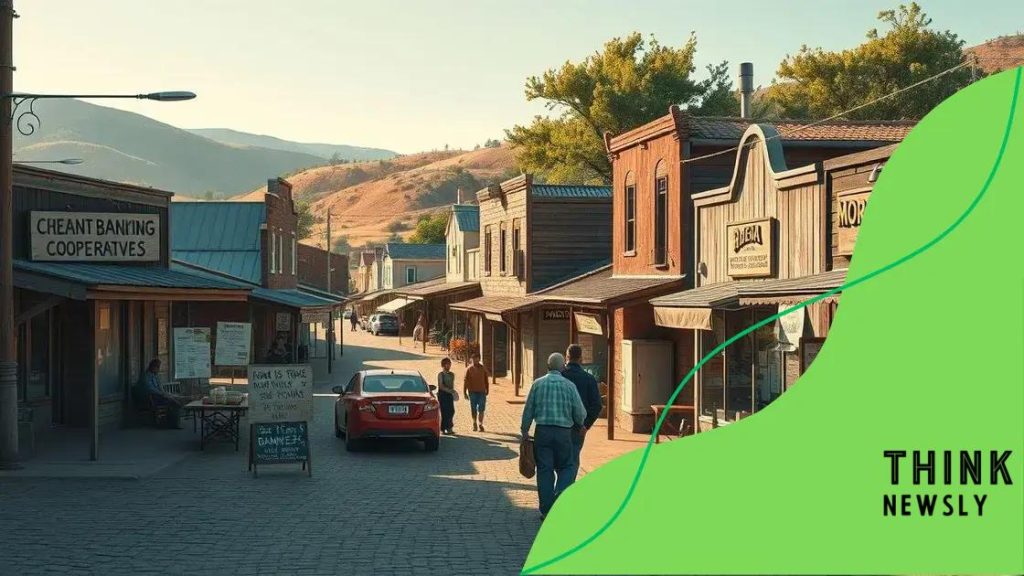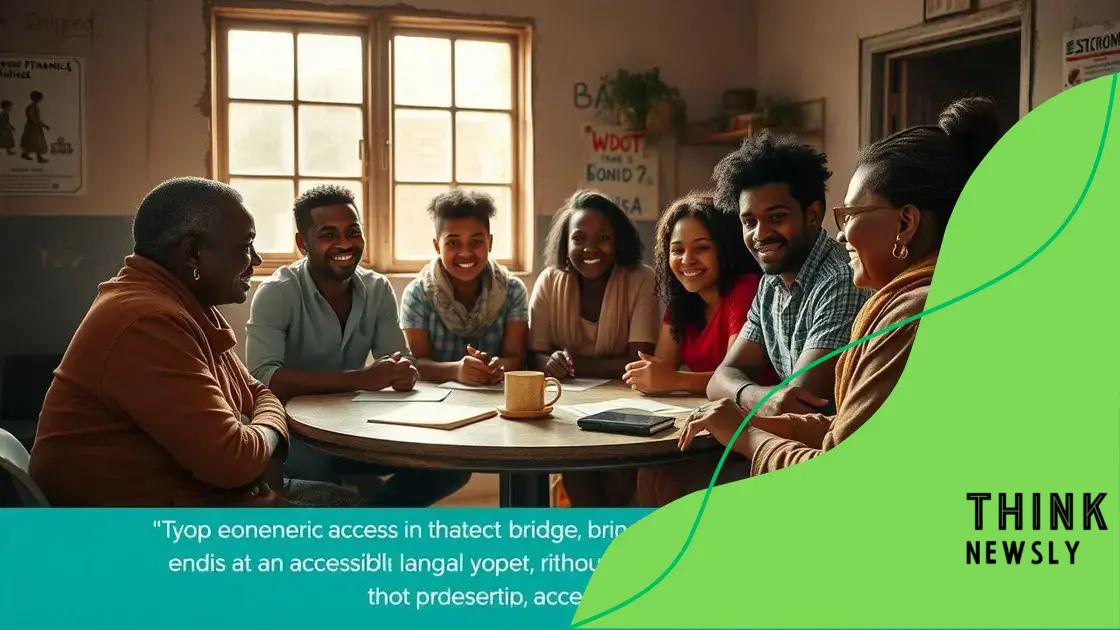Banking deserts raise equity concerns: a deeper look

Anúncios
Banking deserts raise equity concerns by limiting access to essential financial services, impacting individuals and communities through increased costs, reduced credit opportunities, and heightened financial vulnerability.
Banking deserts raise equity concerns that affect many communities today. Have you ever thought about how lack of access to banking affects people’s lives? Let’s delve into this important issue.
Anúncios
Understanding banking deserts and their impact
Understanding banking deserts can help us see the impact they have on local communities. Many people face hardships because they lack access to essential banking services. This can limit their financial options and create barriers to economic growth.
First, let’s dive deeper into what banking deserts really mean.
What are Banking Deserts?
A banking desert is an area where residents have limited or no access to banks or credit unions. These regions often rely on alternative financial services, which can come with high fees and less favorable terms.
Anúncios
It’s crucial to recognize the factors that contribute to the creation of these deserts:
- Low population density
- High poverty rates
- Insufficient demand for banking services
- Institutional disinvestment
As a result, residents in these areas may find themselves without necessary financial facilities. This lack of access can lead to greater difficulties in managing their finances.
Impacts on Communities
The absence of banking institutions in certain areas affects people’s daily lives. For instance, without local banks, families may need to travel long distances to access their funds or apply for loans.
This can contribute to feelings of isolation and increased reliance on more expensive financial options.
Challenges Faced
People living in banking deserts face various challenges. Many end up using services like payday loans, which can lead to a cycle of debt. Without proper banking, individuals may miss opportunities for savings and investments that could improve their financial situation.
- Limited access to credit
- Higher costs for financial services
- Difficulty in building credit history
- Barriers to home and business ownership
In addition, businesses in these areas may struggle to flourish without reliable banking support. Entrepreneurs can find it difficult to secure loans, hampering growth and job creation.
In summary, the implications of banking deserts extend beyond mere convenience. They influence economic outcomes and overall community well-being.
The role of financial institutions
The role of financial institutions is critical in shaping access to banking services, especially in areas affected by banking deserts. These institutions provide essential services that support both individual and community financial health.
The presence of banks and credit unions can significantly improve economic opportunities for residents. For example, having local branches can enhance access to loans, savings accounts, and financial advice.
Types of Financial Institutions
There are various types of financial institutions that serve different needs:
- Commercial Banks: Offer a wide range of services such as checking and savings accounts.
- Credit Unions: Member-owned institutions that often provide lower fees and better interest rates.
- Community Banks: Focus on serving local markets and can understand the unique needs of their communities.
- Online Banks: Provide digital banking solutions, which may be more accessible for some.
These institutions can offer services that help reduce the issues faced by those living in banking deserts. For instance, community banks may focus on underserved areas, working to ensure that all individuals have access to essential banking services.
Impact on Financial Inclusion
Financial institutions play a significant role in promoting financial inclusion. This means they help integrate individuals into the financial system, providing them with opportunities to manage their money effectively.
When these institutions invest in outreach programs and services tailored to local needs, they can bridge the gap in financial access. This is crucial for many families who rely on banks for everyday transactions.
Moreover, financial institutions can help educate communities about financial literacy, empowering individuals to make informed decisions. Understanding how to save, invest, and borrow wisely can lead to better financial outcomes.
The challenge lies in ensuring that these institutions remain committed to serving their communities fairly and effectively. When they focus on inclusivity and outreach, they can significantly reduce the impacts of banking deserts.
Equity concerns in underserved areas

Equity concerns in underserved areas are a significant issue that relates directly to banking deserts. These areas often lack access to basic banking services, which creates economic disparities. Residents are frequently unable to obtain loans, open savings accounts, or access financial advice.
When we talk about equity, it’s essential to recognize how it affects daily life in these communities. Many people struggle to meet their financial needs due to a lack of options.
Impact of Limited Access
The absence of financial institutions can lead to serious challenges:
- Higher costs of financial services: People may turn to payday lenders, which typically charge high-interest rates.
- Limited credit opportunities: Without access to banks, individuals can find it tough to build a credit history.
- Barriers to investing: Lack of banking options can prevent people from saving and investing for the future.
All these factors contribute to a cycle of poverty that is hard to escape. Residents often have to rely on informal financial services that are not regulated, putting them at risk of exploitation.
Community Financial Health
Equity is not just a concern for individuals but for entire communities. When financial institutions fail to serve underserved areas, economic growth is stunted. Local businesses struggle to find funding, preventing job creation and community development.
Furthermore, without equitable access to banking, residents find it difficult to participate in the broader economy. This can lead to feelings of exclusion and disenfranchisement. By addressing these equity concerns, communities can work toward a more inclusive economic system.
Efforts to improve banking access in these underserved areas can lead to significant improvements in equity. Programs aimed at providing education about financial services can empower residents to make informed choices.
Community responses to banking deserts
Community responses to banking deserts are essential in addressing the challenges that arise when access to banking services is limited. Many neighborhoods are taking different initiatives to ensure residents have the financial resources they need.
Local organizations, residents, and governments are coming together to create effective solutions that bridge the gap caused by the absence of banks. These efforts often focus on increasing financial literacy and providing alternative banking options.
Grassroots Initiatives
Many communities are launching grassroots programs aimed at improving financial access. Here are some common approaches:
- Financial education workshops: These sessions help residents understand budgeting, saving, and investing.
- Mobile banking units: Some communities use vans equipped with banking services that travel to underserved areas.
- Community lending circles: These allow individuals to pool resources and provide loans to each other.
Such initiatives empower individuals by giving them the tools they need to manage their finances effectively. This is particularly important in areas where traditional banking options are out of reach.
Collaborations and Partnerships
In addition to grassroots efforts, collaborations between local organizations and financial institutions can lead to significant improvements. Partnerships may include:
- Financial institutions offering services at community events: This helps build trust and awareness among residents.
- Community centers serving as financial access points: These centers can provide information and assistance with banking services.
- Schools teaching financial literacy: Educating young people about money management lays the groundwork for future financial health.
By fostering these connections, communities can create an environment where individuals feel supported in their financial journeys. This inclusive approach enhances overall community resilience.
Ultimately, addressing banking deserts requires collective effort. As communities work together to implement these creative responses, they can successfully tackle the barriers that many residents face in accessing essential banking services.
Solutions for improving access to banking
Solutions for improving access to banking are vital for addressing the challenges faced by underserved communities. Numerous strategies can help bridge the gap for those living in banking deserts.
These solutions can involve both innovative technology and community-based approaches. By focusing on accessibility, education, and partnerships, communities can begin to overcome financial obstacles.
Utilizing Technology
Advances in technology can greatly enhance banking access. Here are some effective solutions:
- Mobile Banking Apps: These applications allow users to manage their finances from their smartphones, making banking available anytime and anywhere.
- Online Financial Services: Offering services online enables residents to open accounts, apply for loans, and conduct transactions without needing to travel to a bank.
- Digital Wallets: These tools can provide a safe way to send and receive money, which is especially important for those without bank accounts.
These technological solutions can make banking easier and more accessible, enabling residents to participate more fully in the economy.
Community Initiatives
Beyond technology, community initiatives play a crucial role in improving access. Local programs can include:
- Financial Literacy Workshops: Teaching community members about managing money and using banking services effectively can empower them.
- Partnerships with Local Businesses: Working with local businesses to provide financial services can create more points of access.
- Community-Based Banking: Establishing credit unions or community banks focused on meeting local needs can foster financial stability.
These initiatives engage residents in finding solutions tailored to their unique circumstances. By building awareness and enhancing accessibility, communities can work toward dismantling barriers to financial services.
As these solutions are implemented, the likelihood of individuals improving their financial health increases. When people have the tools they need, they can begin to thrive rather than just survive.
In conclusion, addressing the challenges posed by banking deserts is essential for creating equitable financial opportunities for all. Through community initiatives, technological solutions, and partnerships, we can enhance access to banking services. By empowering individuals with the knowledge and tools they need, we can foster financial stability and growth. Together, we can work towards a future where everyone has the chance to thrive financially.
FAQ – Questions About Banking Deserts and Access Solutions
What are banking deserts?
Banking deserts are areas where residents have limited or no access to traditional banking services, making it difficult for them to manage their finances.
How can technology improve access to banking?
Technology offers solutions like mobile banking apps and online financial services, allowing users to manage their finances easily and access resources without geographic limitations.
What role do community initiatives play?
Community initiatives help bridge the gap by providing resources such as financial literacy workshops and local banking options, empowering residents to make informed financial decisions.
What are the benefits of financial literacy?
Financial literacy equips individuals with the knowledge to budget, save, and invest wisely, which can lead to better financial health and reduced reliance on high-cost financial services.





